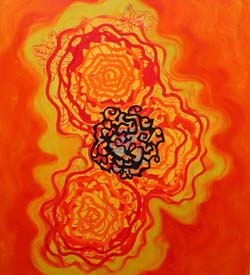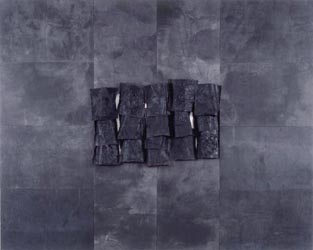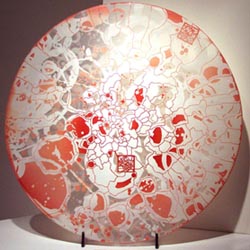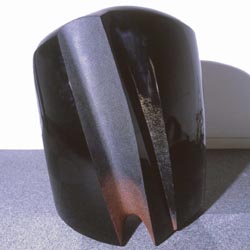


back to
On Exhibit

 Emily Cheng is an well-regarded oil painter and educator whose current work, the Mandela series, offers a spiritual encounter for the viewer, tracing the circular mazes of her work to the center of the canvas, focusing as T.S. Elliot writes on "the still center of a turning world." Her practice is one of highly edited citation that brings the quoted and adapted elements together into heterogeneous, multi-leveled, synthetic structures. Cheng's extremely diverse imagery directs attention to the tender, the small, the overlooked. It is drawn principally from the high art tradition of painting and ornament, on both the European and Chinese continents. Her art takes us from a global culture into the state of her own mind.
Emily Cheng is an well-regarded oil painter and educator whose current work, the Mandela series, offers a spiritual encounter for the viewer, tracing the circular mazes of her work to the center of the canvas, focusing as T.S. Elliot writes on "the still center of a turning world." Her practice is one of highly edited citation that brings the quoted and adapted elements together into heterogeneous, multi-leveled, synthetic structures. Cheng's extremely diverse imagery directs attention to the tender, the small, the overlooked. It is drawn principally from the high art tradition of painting and ornament, on both the European and Chinese continents. Her art takes us from a global culture into the state of her own mind.
 In contrast to Cheng's bright canvases, Lin Yan exhibits mixed media paintings in black. Her work is a personal reflection on her surroundings, a female response to the mute aggression of some Western minimalism. The forms of the "To Beijing" series recall roof shingles and beams from the old Beijing city as an elegy to the city she remembers. Meanwhile, the color black makes reference to the rich ink shades of the traditional Chinese painting and creates a mysterious depth with the blank space made of layers of traditional handmade paper. As a result, her works have a delicacy that owes more to the restrained spirituality of Ad Reinhardt than to the brute materiality of Richard Serra. Two new works done after 9/11 show the hope and inspiration of life nascent in New York City's mourning. Thus, Lin Yan melds her multiple influences to reshape the minimalist vocabulary to her own purposes. By self-consciously simplifying her means of expression, she produces a poetry that transcends the bounds of East and West.
In contrast to Cheng's bright canvases, Lin Yan exhibits mixed media paintings in black. Her work is a personal reflection on her surroundings, a female response to the mute aggression of some Western minimalism. The forms of the "To Beijing" series recall roof shingles and beams from the old Beijing city as an elegy to the city she remembers. Meanwhile, the color black makes reference to the rich ink shades of the traditional Chinese painting and creates a mysterious depth with the blank space made of layers of traditional handmade paper. As a result, her works have a delicacy that owes more to the restrained spirituality of Ad Reinhardt than to the brute materiality of Richard Serra. Two new works done after 9/11 show the hope and inspiration of life nascent in New York City's mourning. Thus, Lin Yan melds her multiple influences to reshape the minimalist vocabulary to her own purposes. By self-consciously simplifying her means of expression, she produces a poetry that transcends the bounds of East and West.
 Arlan Huang's glass inventions represent a family history passed down from generation to generation. The first one hundred glass stones were imbued with a story or reminder of the relationship between Huang and his grandfather. While light giving, translucent, fragile and breakable, they are also solid and heavy as lead-a burden as well as a legacy. His "Jade Mountain D-Tour" series is a modern interpretation of Chinese jade, stone and glass carving. Wrapped in layers of color, the series pays homage to the time when forgotten artisans honed and perfected the art of Jade Mountain carving through a thousand years of handwork. This series contributes to Huang's goal of ten thousand smooth stones in blown glass. Each stone is sequentially numbered to mark the passage of time and represents the unfolding story of Huang's lifelong commitment to art. In Visual Dialogue, Huang will exhibit his most recent works-white hollowed stones with a very smooth surface and subtle, light colors. The simpler forms exude serenity.
Arlan Huang's glass inventions represent a family history passed down from generation to generation. The first one hundred glass stones were imbued with a story or reminder of the relationship between Huang and his grandfather. While light giving, translucent, fragile and breakable, they are also solid and heavy as lead-a burden as well as a legacy. His "Jade Mountain D-Tour" series is a modern interpretation of Chinese jade, stone and glass carving. Wrapped in layers of color, the series pays homage to the time when forgotten artisans honed and perfected the art of Jade Mountain carving through a thousand years of handwork. This series contributes to Huang's goal of ten thousand smooth stones in blown glass. Each stone is sequentially numbered to mark the passage of time and represents the unfolding story of Huang's lifelong commitment to art. In Visual Dialogue, Huang will exhibit his most recent works-white hollowed stones with a very smooth surface and subtle, light colors. The simpler forms exude serenity.
 In contrast to Huang's light color glass stones, Guoqing Heaton, will show for the first time in New York three of her major black Zen sculptures. Her highly accomplished lacquer making technique is a product of assiduous study of traditional "dry lacquer" production methods and continues the great tradition of lacquer making in East Asia. While deriving inspiration from nature, like all great Chinese art from the past, she also pays homage to pure abstraction as it is understood in the West. Heaton's work serves to bridge the gulf that separates the ancient Han dynasty lacquer masters and the great sculptors of our own time.
In contrast to Huang's light color glass stones, Guoqing Heaton, will show for the first time in New York three of her major black Zen sculptures. Her highly accomplished lacquer making technique is a product of assiduous study of traditional "dry lacquer" production methods and continues the great tradition of lacquer making in East Asia. While deriving inspiration from nature, like all great Chinese art from the past, she also pays homage to pure abstraction as it is understood in the West. Heaton's work serves to bridge the gulf that separates the ancient Han dynasty lacquer masters and the great sculptors of our own time.
*The "dry lacquer" techniques used by Heaton have been in continuous use in East Asia for at least 2000 years. The products of this technique have long been highly prized throughout Asia for their unique combination of beauty, utility and extraordinary durability. Because of the extreme difficulty, expense and production time requirements, works in lacquer have been reserved for the use and enjoyment of the very few. Its importance in the lives of the ruling classes of both China and Japan meant that the making of lacquer ware was often regulated by imperial authority, and the artisans were registered and protected so their secrets would not pass into inappropriate hands.